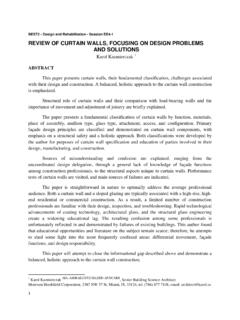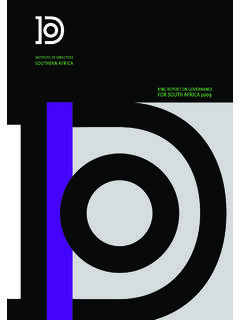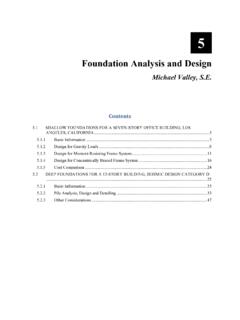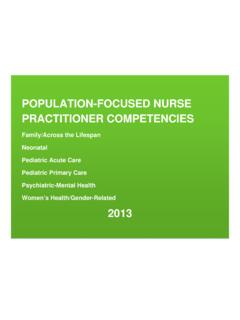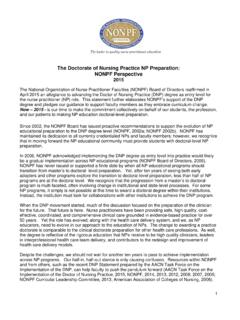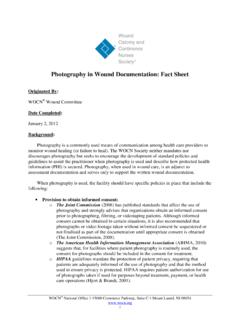Transcription of Chapter 4: System Approaches and the Social Ecological Model
1 1 Chapter 4: System Approaches and the Social Ecological Model Upstream Possibilities A Public Health Parable A man and woman were fishing downstream and suddenly a person came down the river struggling for life. The fisher folk wade into the quickly moving water and pull the person out, saving her life. Then another person comes along and again must be rescued. This happens all afternoon and the fisher folk get very tired from constantly pulling people from the river. Eventually they think, We need to go upstream and find out why so many people are falling in the water. When they go upstream, they find that people are drawn to the edge to look at the river, but there is no safe way to do this and many of the people keep falling in. The fisher folk go to the community leaders and report the number of people who have fallen into the river.
2 They also report that this is because of the lack of a protective barrier on the cliff. Community leaders build a wall behind which people may safely view the water. Some still fall, but there are many fewer people to rescue. Author unknown In addition to measuring chronic disease burden, chronic disease epidemiologists have the opportunity to look upstream and work with program partners to implement prevention and control strategies with potential to impact the greatest number of residents. Therefore, this Chapter reminds you as the lead chronic disease epidemiologist that different levels of society can impact individual behavior and that several frameworks describe these levels or interventions at these levels. This Chapter will foster your thinking about how Social context and community factors can drive behaviors affecting chronic diseases.
3 Part of your role as the lead chronic disease epidemiologist is to measure these contextual factors to better understand the relationships among the environment, individual behaviors, and population health outcomes. Additionally, this Chapter describes the potential role of these relationships in informing the development of policy, systems, and environmental changes targeted at the different societal levels to help promote improved population health. While individuals are responsible for initiating and maintaining the behaviors necessary to reduce risk and improve health, their behavior is influenced to a large 2 extent by the context in which they live ( , Social determinants of health). The Social forces are life threatening. Researchers from Columbia University estimated deaths attributable to Social factors in the United States in 2000: 245,000 deaths attributed to low education; 176,000 to racial segregation; 162,000 to low Social support; 133,000 to individual-level poverty, 119,000 to income inequity, and 39,000 deaths to area-level As stated in a 2000 Institute of Medicine report on health promotion, "It is unreasonable to expect that people will change their behavior easily when so many forces in the Social , cultural, and physical environment conspire against such change.
4 "2 By identifying determinants of health, you as the lead chronic disease epidemiologist can guide interventions that help communities overcome these barriers and allow for the healthy choice to become the easy and life-extending choice. For the senior epidemiologist or professional who supervises or mentors the lead epidemiologist, you can use this Chapter to identify and share previous analyses that informed environmental, System , or policy changes and their success or failure in preventing chronic diseases or reducing the impact of diseases on activities of daily living. If your department has its own Model for systems thinking and/or for Social determinants of health, provide it to the lead chronic disease epidemiologist. For the entry-level epidemiologist assess whether or not the surveillance System that you use or know best includes measures of Social or environmental context.
5 Understand the Levels of Public Health Intervention and Their Influence Public health interventions to prevent and control chronic illness can be implemented at any (or all) societal level(s), from the individual to the institutional to the entire community or state. More recently state public health departments have shifted from providing or funding individual direct services (intervening directly at the individual level) to improving a System of services (intervening at the organizational and community level). Social Ecological Model A useful framework describing a systems approach at various societal levels is the Social Ecological Model (Figure 4-1).3 This Model recognizes and articulates the relationship between the individual and their environment. The Social Ecological Model can have four or five levels.
6 At the center or base is the individual level of internal determinants of behavior, such as knowledge, attitudes, beliefs, and skills. The interpersonal level comprises the external influences of family and friends, the individual s physician as well as key opinion leaders. Social norms, Social identify and role definition form and operate at this level and can influence lifestyle and health care choices. The 1 Galea S, Tracy M, Hoggatt KJ, DiMaggio C, and Karpati A. Estimated deaths attributable to Social factors in the United States. Am J Public Health. 2011; 101(8): 1456-1465. 2 Institute of Medicine Committee on Capitalizing on Social Science and Behavioral Research to Improve the Public's Health. Smedley BD, Syme SL, eds.
7 Promoting Health: Intervention Strategies from Social and Behavioral Research. Washington DC: National Academy Press; 2000:2. 3 Social Ecological Model . Center for Disease Control and Prevention Website. Available at: Updated January 25, 2013. Accessed April 11, 2015. 3 institutional or organizational level considers the rules and policies that guide and support behavior, including healthy behavior, in the assemblies that aggregate interpersonal associations, such as the workplace, schools and Social organizations. The fourth level, the community, is the collective network of individuals, businesses, institutions and organizations. These larger Social constructs, which include the media and advocacy groups, can be defined by geography, membership, heritage or affiliation.
8 The last level, the policy level, describes the authoritative decisions made by a local, state, or federal governing body that can influence all the other levels. For example, federal, state, local or tribal government officials can support chronic disease prevention and control through laws, ordinances, regulations or proclamations. Figure 4-1. Social Ecological Model As adapted by: Colorectal Cancer Control Program (CRCCP). Centers for Disease Control and Prevention Website. Available at: Updated January 25, 2013. Accessed April 11, 2015. 4 The Health Impact Pyramid Dr. Thomas Frieden's five-tier, Health Impact Pyramid, Figure 4-2, can be described as an adaptation of the Social Ecological Model . In place of the five levels of possible public health intervention, the pyramid depicts five types of interventions and their relative population The five tiers of the pyramid are, from bottom to top, socioeconomic factors ( , decreasing the negative impacts of poverty), changing the context to make individuals default decisions healthy ( , eliminating trans fat), long-lasting protective interventions ( , colonoscopy, treatment of tobacco addiction), clinical interventions (treatment of hypertension and hyperlipidemia), and counseling and education ( , dietary counseling).
9 Like the Social Ecological Model , the Health Impact Pyramid suggests that interventions with greater population reach and which require least individual effort will have the greatest overall public health impact. Moreover, these population-level interventions are potentially more sustainable as, unlike individual-level focused activities, they typically do not require considerable ongoing financial support and are not impacted by limits in scalability. Figure 4-2. The Health Impact Pyramid Figure used with permission from AJPH. Frieden TR. A Framework for Public Health Action: The Health Impact Pyramid. Amer J Pub Health. 2010; 100(4): 590 595. 4 Frieden TR. A framework for public health action: the Health Impact Pyramid.
10 Am J Pub Health. 2010; 100(4): 590 595. Increasing Individual Effort Needed Increasing Population Impact Increasing Individual Effort Needed Increasing Population Impact Increasing Individual Effort Needed Increasing Population Impact 5 The Maternal and Child Health Pyramid The MCH pyramid is a conceptual framework for four tiers of services funded by the Title V Maternal and Child Health Block Grant ( ). Older than the Health Impact Pyramid, this framework used a pyramid to show the same impact, that the lowest tier had the largest reach in terms of population impact and the top tier the smallest. Its four tiers from top to bottom are: Direct health care services (for gap filling) Enabling services (transportation, translation, outreach, respite care, health education, family support services, case management coordination with Medicaid) Population-based services (newborn screening, lead screening, immunizations, oral health, injury prevention, nutrition, outreach, public education) Infrastructure-building services (needs assessment, evaluation, planning, policy development, quality assurance, standards development, monitoring, applied research, systems of care, information systems, training)
